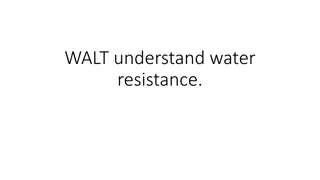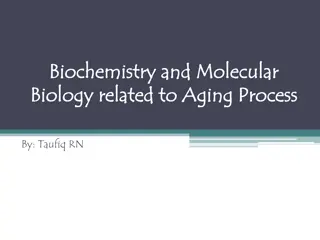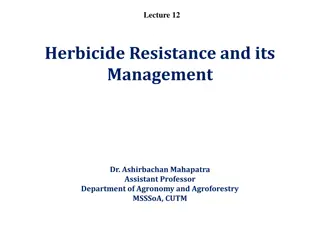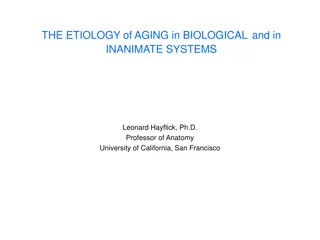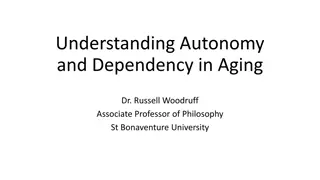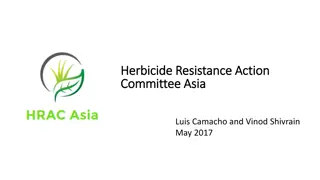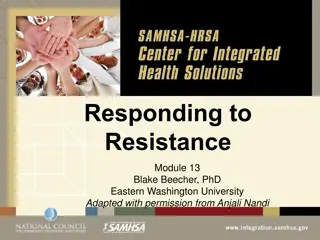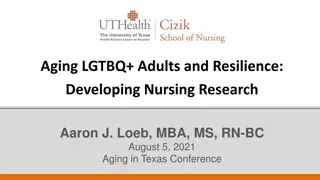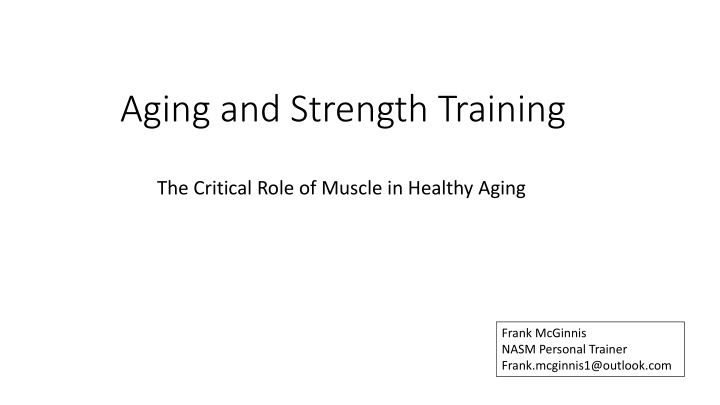
Strength Training for Healthy Aging: Role of Muscle in Maintaining Functionality
Explore the critical role of muscle in healthy aging and how strength training can combat age-related decline. Learn how inactivity, not just age, can lead to weakness and loss of balance. Discover the impact of aerobic capacity decline and muscle mass loss as we age, and the benefits of properly designed strength training programs in maintaining strength and functionality.
Download Presentation

Please find below an Image/Link to download the presentation.
The content on the website is provided AS IS for your information and personal use only. It may not be sold, licensed, or shared on other websites without obtaining consent from the author. If you encounter any issues during the download, it is possible that the publisher has removed the file from their server.
You are allowed to download the files provided on this website for personal or commercial use, subject to the condition that they are used lawfully. All files are the property of their respective owners.
The content on the website is provided AS IS for your information and personal use only. It may not be sold, licensed, or shared on other websites without obtaining consent from the author.
E N D
Presentation Transcript
Aging and Strength Training The Critical Role of Muscle in Healthy Aging Frank McGinnis NASM Personal Trainer Frank.mcginnis1@outlook.com
A lot of the symptoms that we associate with old age such as weakness and loss of balance are symptoms of inactivity, not age . - Alicia Arbaje MD Professor of Geriatrics Johns Hopkins School of Medicine
Overview In the traditional view of development humans gain increasing physical capability from birth until about age 35. From there, humans experience a steady physical decline until old age renders them frail and helpless However, science has found this age decline is not inevitable. Many of the diseases associated with aging and frailty are due to loss of muscle A properly designed strength training program can build and maintain an individual s strength and muscle mass as he/she ages chronologically
Traditional View of Health Span The most you can do Functional Ability The least you can do The least you can do 0 35 80 65+ Age
The Human Body Evolved Through Physical Movement Survival depended on MOVEMENT: Find/forage edible vegetation Track and kill game Fight/flee predators Locate shelter Discovery of Agriculture Emergence of Homo Sapiens -10,000 Today -300,000 290,000 Years
Declining Functionality in Aging Adults Muscle mass declines about 10% per decade after age 35. This decline accelerates after age 65 Aerobic capacity declines about 5% per decade starting at age 30 and 20% per decade after age 70 By age 70 most Americans have lost 35-40% of the muscle mass and 20% or more of the aerobic capacity they had in their 30s
MRI of Mid MRI of Mid- -Thigh: Active vs Sedentary Adults Thigh: Active vs Sedentary Adults 40-year-old Triathlete: Mostly muscle 74-year-old Sedentary Male: Mostly fat 70-year old Triathlete: Primarily muscle
The Cost of Lost Strength and Muscle The Cost of Lost Strength and Muscle Sarcopenia is associated with: Osteoporosis Heart disease Chronic inflammation Obesity Type 2 diabetes Limited mobility Depression Sarcopenia Loss of muscle mass as we age
A prime example of disease associated with atrophied muscle is Type II diabetes which occurs when atrophied muscles can t store glucose and fat stores are excessive. Continued carbohydrate consumption means glucose remains in the blood stream. Type II Diabetes Immediate Fuel Muscle Storage Carbohydrates Glucose Fat Storage Blood Stream
Aging and Falls Aging and Falls 1 in 4 people over age 65 fall each year For people over 65, 50% of injuries requiring hospitalization are due to falls The highest occupancy rate at trauma centers of major hospitals nationwide is the elderly suffering from ground level falls For people over 65 the leading cause of death from injury is a fall
Increasing Health Span The most you can do Resistance Training Functional Ability The least you can do The least you can do 0 35 65 80 Age
Muscle: The Key to Longer Health Span Muscle: The Key to Longer Health Span Muscle is the largest and most adaptable organ in the body. It declines not from age but from disuse Research since the 1990 s indicates healthy muscle mass is key to avoiding many of the diseases attributed to old age Strength and muscle mass can be maintained or even increased as we age
Myokines Myokines In the early 2000 s scientists discovered that muscle is more than just a mechanism for limb movement: Muscle is an endocrine organ sending signals to virtually every physical system Through peptides called myokines, muscles send chemical messages to the heart, arteries, bones, pancreas, liver, gut, fat cells and brain helping to regulate bodily systems Muscle mass, or lack thereof, affects diseases such as osteoporosis, heart disease, type 2 diabetes, obesity and even cognitive ability
Myokines: Muscle Myokines: Muscle - - Organ Communication Organ Communication Through myokines muscle sends signals to the whole body: Heart Arteries Bones Pancreas Liver Fat cells Brain
Through myokines healthy muscle initiates Through myokines healthy muscle initiates improvement throughout the body improvement throughout the body Body System Benefits from Healthy Muscle Fat Decreases visceral fat; reduces inflammation Bone Improves bone mineral density Blood Stimulates formation of new blood vessels Insulin Improves insulin sensitivity Immune System Brain Recruits and activates immune cells Enhances learning and memory
Age Reversal Age Reversal In 2007, Dr. Simon Melov, in a study founded by the NIH, found that resistance exercise partially reverses aging at the DNA level in human skeletal muscle The study analyzed DNA from muscle biopsies of younger and older adults. The older adults DNA showed gene expression typically associated with aging muscle After 6 months of resistance training, the older adults increased their strength by 50% At study conclusion DNA from muscle tissue of the older adults appeared much closer to that of the younger subjects
(RE) Gaining Strength (RE) Gaining Strength
A large and growing body of scientific research confirms the benefits of A large and growing body of scientific research confirms the benefits of resistance training for older adults resistance training for older adults Once Weekly Resistance Exercise Improves Muscle Strength in Older Adults Journal of American Geriatrics Society, 1999 Strength Training Improves Metabolic Health in Older Individuals Frontiers in Physiology, 2019 Resistance Training for Older Adults: Position Statement National Strength and Conditioning Assoc. - Journal of Strength and Conditioning 2019 Effect of Resistance Training on Muscle Strength in Healthy Older Adults - Experimental Gerontology, 2018 Strength gains of 174% in Nonagenarians (ages 90 +) with 8 weeks of High Intensity Strength Training - JAMA 1990
Principles of Proper Strength Training Principles of Proper Strength Training Principle Description Overload Initial resistance (weight) must be sufficiently challenging Intensity Exercise effort proceeds until the trainee reaches momentary muscular failure (usually 8-12 repetitions) Form Exercise performed slowly to ensure proper recruitment of muscle fiber Volume Once muscular failure is reached, no additional sets are required or desirable Recovery Muscle strengthens after the workout. The body requires sufficient recovery to grow; usually 3-7 days between workouts Progression Effort is made to increase resistance or repetitions at each workout
Typical Workout Typical Workout Exercises 5-6 exercises targeted at major muscle groups: Legs Back and Chest Arms and Shoulders Length Approximately 30 minutes Frequency 1-2 workouts per week
Results Results Clients aged 65-90 have achieved remarkable strength gains in 3-6 months Example: 86-year-old male with left shoulder replacement gained full range of motion of left arm and increased full body strength 85% in 6 months Example: 67-year-old female increased full body strength 74% in 3 months Example: 76-year-old male after quintuple heart by-pass increased lower body strength by 28% in 4 weeks Example: 73-year-old female with osteoporosis increased full body strength 83% in 2 months
Benefits of Maintaining Strength Benefits of Maintaining Strength Benefits Improved strength and balance Enhanced disease resistance Increased muscle and lower fat Higher bone density Improved cognitive function Reduced arthritis symptoms Less back pain Implications Mobility Confidence Independence






